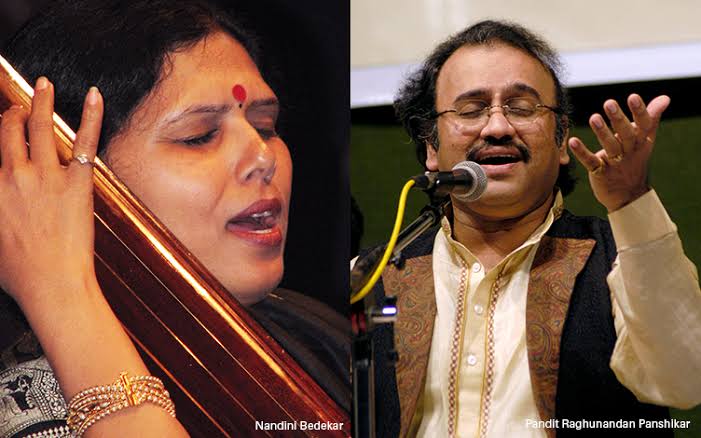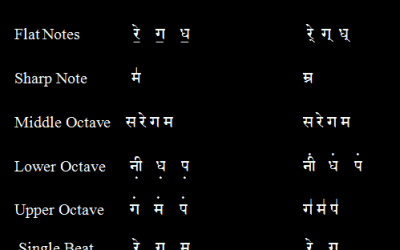In new method in the management of six elements (Swara, virudh, Tenak, pad, paat and taal) 3 started getting used. ‘Paad’, and ‘Virudh’ I considered mean similarly their management is more.
Following is their description:
Drupad
It is said that Drupad was first originated by king Maan Singh Tomar in the 15th century. himself pioneered some drupads in ancient times, scholars and monks used to work worship God using drupads in Sanskrit style.
in present time also, Drupad is considered one of the serious and strong song. Drupad singing can also be seen in some languages such as Hindu, Urdu, braj language. it is a male voice singing. its ornaments can be peace, makeup etc.
Anup Sangeet Ratnakar has described drupad in the following way:-
there are four parts in drupad namely ‘sthaai’ , ‘antara’ , ‘sanchari’ and ‘abhog’ .Drupad is mostly sang with ‘chautaal’ , ‘saalphaak’ , ‘jhalpa’ , ‘tivra’ , ‘bramtaal’ and ‘rudrataal’ etc. ‘Taals’ are not used with drupad , but ‘dugun’ , ‘chaugun’ , ‘boltaan’ etc are used.
Four laws of Drupad
Frupad who was known as kalawat in ancient times. Types of drupad singers came to be known as ‘Vaani’. Four ‘Vaanis’ are namely – 1. Gobarhaar Vaani or Shudh Vaani 2. Khandhaar Vanni 3. Daagur Vaani 4. Nohaar Vaani
In emperor Akbar’s Empire, we had four great monks- 1. Tansen 2. Braj Chand Bhahman (resident of dagar village) 3. Raja Samokhan Singh (resident of a place called binaakar) 4. Srichand Rajput (resident of Nohar).
For Vaanis were famous by these four in Akbar’s empire. Tansen being a Gaud brahman was named ‘Gaudiya’ or ‘Gobarihari’. Due to famous Veenaakar Mohan Singh’s marriage with Tansen’s daughter, his name was decided by Naubad. Naubad khan’s place of residence was Kandahar , hence his vaani was named khawaahar – Vaani . According to the place of residence of Brahmachand his voice is named Dagar – Vaani . Rajput was a resident of Srichand Nohar , hence the name of Vaani became ‘Nohar Vaani’
The main characteristics of four Vaanis –
- Gobarhar-Vaani : Its main characteristic is prasad guna, it is silent and its speed is comparatively slow.
- Khandahar – Vaani: Different and opulence shine are characteristics of this type of Vaani.
- Dagar Vaani: It is easy and simple. Its speed is too simple and spontaneous. In this Vaani, different laps of voices and swaras are displayed in a bizzare form.
- Nohar-Vaani: Nohar demonstrates the speed of the lion. It is characterized by skipping two-to-one swaras and reaching to the targeted swara is its goal. Nohar Vaani doesn’t particularly make any kind of flavour, still, there is something amazing in it.
We do not call it Vaani or Shudh Vaani, it is like other vaanis such as Gabarhar and Dagar Vaani, the difference is just in calling its name. Pure Vaani is the belief of music and this only makes music prestige. Shudh Vaani is the soul of music, just like a pure waterfall. It is said that the one who has enjoyed its beauty before can only experience its bliss. That’s why people under Tansen used to sing in shubh vaani and was given more importance.
In the other Vaanis of music. If presented as an empire, Gobarhar (Godiya) is pronounced Vaani who is the king. Dagar vaani is given the rank of minister, Khadahar Vaani as commander in chief and Nohar as a servant. Each has its own significance in its place. Gobarhar vaani has a particular swara which is created in a fixed manner. Clarity is the main feature of this Vaani. Dagar vaani, the peculiarity in which one tone is found with the other in the vaani creates a strange and mysterious feeling in it. By not expressing the voice clearly, one has to reveal it according to the imagination of a listener. Elegance and solemnity are found sufficiently in both these works. Khandahar-Vaani is called ‘Bhinna Geeti’ in sanskrit.
* Sing different pieces of swaras in this vaani. Perhaps this is why in Sanskrit it is called ‘Bhinna’. in Hindi, it is called ‘Khandahar -Vaani’ volume of the voice.
* The basic meaning of both words is the same. Khandhaar – Vaani characterized by the presence of a clause in a device sense rather than a simple expression by presenting in parts. in this act, the melody of voice is not destroyed, but with the help of subtle ‘gamak’, movement of swara increases the sweetness in it, the best virtuous Gamak is used to sing Khandhar-Vaani was used by people in different types of speed, Gamak and joining. The importance of Shudh Vaani can we see through Rabaab (an instrument), because Swaraj of Rabaab is simple. In this Vaani, big, medium or small all types of alaaps can be seen.
Nowadays there is hardly any single who knows the secret of Vaani. the practice of drupad singing has been over 500 years, but around here the propagation of drupad has been reduced and singing of Khayaal has increased. out of this comma in musical-art penetrating, Dhrupad singing is still seen the point of interest.
Khayal
in Urdu language, khayal means thought or imagination. following the rules of the raga, with our own thought or imagination, different alaaps-taans can be explained with the help of various taals- Ektaal, Teentaal, Jhumra, Adha, Chautaal etc. the use of makeup-beauty flavour is found more. ‘Jalad taan’, ‘Gitkaari’ taan etc increases the beauty, swara’s grace and shine. khayal singing does not have serious and devotion like drupad singing.
there are two types of khayal- 1.recharge song in delayed rhythm often called ‘bada khayal’. 2. Those which are song with fast rhythm are called ‘Chhota khayal’.When the singer starts singing the khayal, first he sings a ‘bada khayal’ in the delayed rhythm which is usually sung in delayed Ektaal, Teentaal, Jhumra, Adha, Chautaal etc. only after it, singing starts to happen in a little fast speed which is sung in teentaal and ‘Drut Ektaal’. ‘Bada-chhota khayal’ , when song at the same time and at the same place then both of them are open in the same raga. but the lyrics and poetry different. in the court of Mughal emperor Muhammad Shah Rangile (1817), the famous Sadarang (Nyamat khan) and Adarang composed thousands of Khayaals and thought their disciples but surprisingly, they did not teach and made to sing not even a single khyal to there descendant. Wazir Khan of Rampur was descendant of sadarang and Mohammed Ali Khan Tansen. They were both drupad singers and khayal singers.
Tappa
Tappa Singing started to propagate after khayal singing. this word tappa has much meaning in the dictionary such as jump, bounce, flaying, difference and kind of song which runs in Punjab full stop it is only appropriate for music students to take the last meaning. it is said that a Punjabi lived in the court of Asif -Ud-Daul, the Nawaab of Lucknow named Shori Mian. it was he who invented the singing of Tappa. Tappa is mostly sung in raagas like ‘Kaafi’, ‘Bhairvi’, ‘Khamaaj’ etc. Its Taans are singing in very prepared nature. The speed of Tappa is very agile. some scholars also believe that this singing originated from ancient ‘Versa Geeti‘.





0 Comments